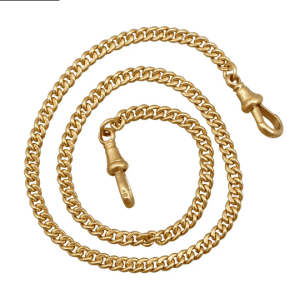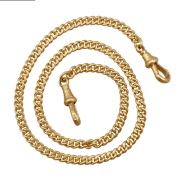Russian Gold
by Eleanor Lippman
Recently, I went to a local jewelry store to have a ring repaired. As I was waiting for the salesman, I noticed a sign announcing the current price of gold. What struck my eye was the sign in large bright blue letters:
Gold is currently valued at $1,572 an ounce
I immediately thought of the small brown velvet pouch my mother gave me before she died. The pouch contained a handwritten note and a heavy gold necklace. The note said, “This is all that is left of the Russian gold chain and pocket watch that Jack (my father) inherited from Mima (aunt) Zlata.” Signed, “Ida”.
“Mima Zlata” was a mystery to me as I struggled to understand relationships in my father’s family. My best guess is that she was the sister of my father’s grandfather. Apparently, Zlata was married to a wealthy Russian Jewish man who had the very unusual ability to travel about freely in Russia, a rare entitlement. Zlata and her husband Neutie (Nathan) eventually came to America and settled in Philadelphia where the rest of my father’s family lived. The Beinstocks were pillars of the Philadelphia Jewish community and they apparently donated a large sum of money to build a synagogue in South Philadelphia, a structure that has long since been torn down. Supposedly, there had been a bronze commemorative sign in the synagogue entryway thanking them for their generosity. The couple never had any children, and after they died, my father’s father inherited some of their belongings. Eventually after his death, their things passed down to my father.
I had put the pouch my mother gave me in the back of a drawer, long forgotten since my move to Oregon ten years earlier. I do remember the story my mother told me about its contents. A pocket watch and its associated watch fob and chain had ended up in my father’s hands because he was the oldest of three siblings.

Russian Gold Chain
It was decided to divide the inherited jewelry between my father Jack, his brother Irv, and their sister. Irv, the younger brother, received the pocket watch because he worked in an office and needed a time piece. The heavy gold chain was cut in two, one half for my father and one half for their sister, Babs.
In reality, my father’s section of the gold chain was too short to become a necklace and too long to be a bracelet so my mother just held on to it for many years. One day she came across a piece of costume jewelry, a necklace composed of curved pieces of what looked like green jade. Separating four of the curved jade-like pieces, she attached them to the neglected Russian gold chain, turning it into an attractive necklace that she could wear. This was the necklace that was in the pouch my mother gave me.
Since green is not really my color, I never wore her necklace, but I kept the note and the necklace in a safe place, just in case. Consider that the chain was massive, not quite as thick as my little finger, and very heavy, so as one could imagine, after reading the sign about the current price of gold, I needed to determine its value. Could it be worth many thousands of dollars? Was I sitting on a small fortune? I had to know. If it was as valuable as I suspected, perhaps I needed to invest in a small safe or even sell the chain before it was unintentionally discarded like so much gaudy costume jewelry.
When I received the telephone call saying my ring was repaired and ready for pickup, I eagerly showed up with the pouch and the necklace for the jeweler to evaluate.
After listening to me telling the story of how the watch and chain was divided among three siblings, the jeweler picked up his magnifying loupe and carefully studied the necklace. First he announced the four “jade” pieces were worthless costume jewelry, just plastic junk, something I already knew. He carefully studied the chain searching for the tiny stamp authenticating the presence of gold. I waited patiently and explained that my section of the chain probably didn’t contain the gold information stamp, it was most likely on the half my aunt inherited. The jeweler kept carefully studying the chain link by link and I kept dreaming of the potential value of so much gold.
Finally, he put down the chain and his loupe and slowly and sadly announced the chain was just costume jewelry — no value whatsoever. Careful examination revealed base metal on several links where the so called Russian gold had worn away, a clear indication the piece was not solid gold. Perhaps, he said kindly, the watch itself was valuable but of course, I didn’t have the watch and had no idea of what had happened to it. He was trying so hard to make me feel better, assuming I had some special connection to the chain – or was counting on the idea it was solid gold. He could see the disappointment in my face and I had to reassure him that there was no emotional attachment and no disappointment on hearing the news. Expecting the chain to be very valuable was like winning or not winning the lottery. Disappointing, but not earth shattering and nothing in my life would change.
I explained to him that in assuming the chain was gold, I would have bragged to my children about the potential value of the “Russian gold” they would eventually inherit, something that was clearly and unfortunately not true.
So now, I am relieved to learn, I will not be embarrassed by letting them think the chain was valuable. I will tell them the story that both I, and my mother as well, had been duped into being good stewards looking after a piece of junk jewelry for many, many years.



Leave a Reply
Want to join the discussion?Feel free to contribute!